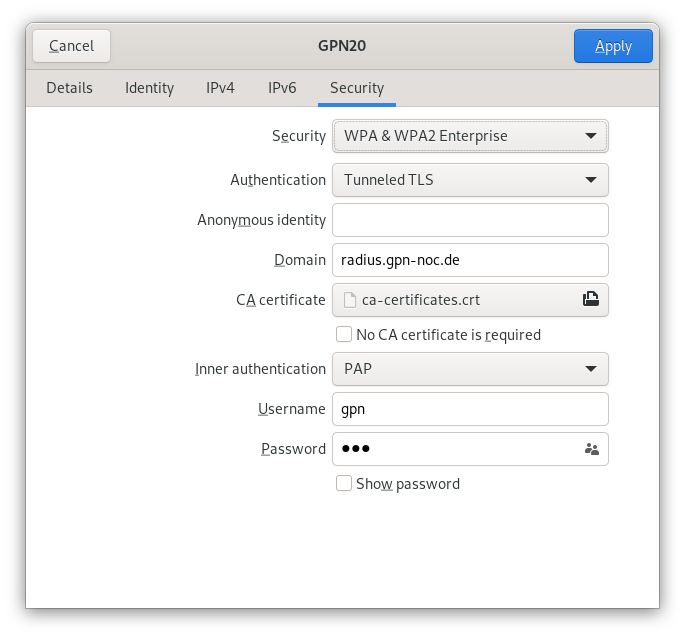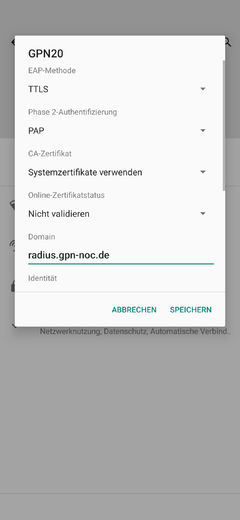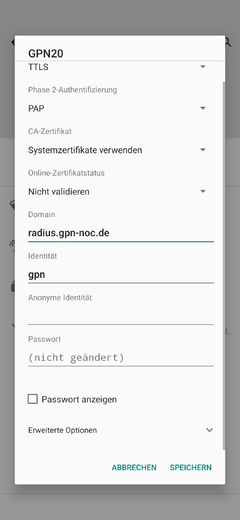(Die Seite wurde neu angelegt: „= Network <copied from GPN19>= Ja, wir haben Internet. Alle bereitgestellten Netze sind '''ungefiltert''' und auf '''öffentlichem IP-Space''', stelle sicher,…“) |
0 (Diskussion | Beiträge) |
||
| (30 dazwischenliegende Versionen von 8 Benutzern werden nicht angezeigt) | |||
| Zeile 1: | Zeile 1: | ||
= | = Buildup / Teardown = | ||
The GPN20 build up takes place on Wednesday, May, 18th and tear down starts on Sunday afternoon, May, 22nd. | |||
Please understand that we're quite a busy folk during that time and we have a lot of stuff getting set up. | |||
This means, we're not angry with anybody, but have a tight schedule we have to follow in order get everything done in time - especially during build up on Wednesday. | |||
If we're very busy or too exhausted and don't find the time to answer your questions or requests, please give us some time and come back later when there is less business at the GPN NOC Desk. | |||
= Network = | |||
Yes, we've got internet. All provided networks are '''unfiltered''', e.g. no firewall, no NAT and use '''public IP adresses'''. Please make sure, all your devices are up-to-date and services running on your devices are configured securely. We recommend to activate a firewall. | |||
Please bring your own network cable (3m - 5m) with you. When connecting your device to the switch, please make sure the cable does not form a tripping hazard or spans between tables. | |||
== Wi-Fi (encrypted) == | == Wi-Fi (encrypted) == | ||
Please consider using a wired connecting in order to save air time. Due to a lot of (new) access points located GPN, HfG and ZKM, air time is really tight. | |||
We'll also have a test stage with 6Ghz Wi-Fi somewhere in the hack center. | |||
* SSID: GPN20 | * SSID: GPN20 | ||
* | * Mode: WPA2-Enterprise | ||
** TTLS/PAP or PEAP/MSCHAPv2 | ** TTLS/PAP or PEAP/MSCHAPv2 | ||
* Username | *** ''(But not TTLS/MASCHAPv2)'' | ||
** | * Username and Passwort | ||
*** Username: <code>gpn</code> | ** for PEAP/MSCHAPv2: | ||
*** Username/Identity: <code>gpn</code> | |||
*** Password: <code>gpn</code> | *** Password: <code>gpn</code> | ||
** | *** Domain: <code>gpn-noc.de</code> | ||
*** | *** CA certificate: <code>Use system certificate</code> ''Note: For Google Pixel 6 (Pro) with Android 12'' | ||
** for TTLS/PAP | |||
*** Domain: radius.gpn-noc.de | |||
*** Everything else: <anything you like - we don't care> | |||
You can also use the following credentials: | |||
* SSID: GPN20 | |||
* Username: <code>protect-me</code> | |||
* Password: <code>protect-me</code> | |||
to have a firewall in place blocking incoming requests, only. | |||
If you want to check that you really connect to the insecure network of ''your'' choice, please verify the certificate of CN <code>radius.gpn-noc.de</code> is issued by [https://letsencrypt.org/certificates/ Let's Encrypt]. | |||
=== wpa_supplicant.conf === | === wpa_supplicant.conf === | ||
| Zeile 24: | Zeile 44: | ||
key_mgmt=WPA-EAP | key_mgmt=WPA-EAP | ||
eap=TTLS | eap=TTLS | ||
identity=" | identity="wiki" | ||
password=" | password="binzufauldaspwzuaendern" | ||
# ca path on debian | # ca path on debian 11.x, modify accordingly | ||
ca_cert="/etc/ssl/certs/ | ca_cert="/etc/ssl/certs/ISRG_Root_X1.pem" | ||
altsubject_match="DNS: | altsubject_match="DNS:radius.gpn-noc.de" | ||
phase2="auth=PAP" | phase2="auth=PAP" | ||
} | } | ||
| Zeile 43: | Zeile 63: | ||
'key_mgmt=WPA-EAP' | 'key_mgmt=WPA-EAP' | ||
'eap=TTLS' | 'eap=TTLS' | ||
'identity=" | 'identity="wiki"' | ||
'password=" | 'password="binzufauldaspwzuaendern"' | ||
'ca_cert="/etc/ssl/certs/ | 'ca_cert="/etc/ssl/certs/ISRG_Root_X1.pem"' | ||
'altsubject_match="DNS: | 'altsubject_match="DNS:radius.gpn-noc.de"' | ||
'phase2="auth=PAP"' | 'phase2="auth=PAP"' | ||
) | ) | ||
== | === Network manager (text file) === | ||
// | |||
// | Create a file <code>/etc/NetworkManager/system-connections/GPN20.nmconnection</code> with the following: | ||
[connection] | |||
// | id=GPN20 | ||
// | uuid=a60a535f-57cb-4fe8-9688-7ff9bd315311 | ||
type=wifi | |||
autoconnect=false | |||
[wifi] | |||
mode=infrastructure | |||
ssid=GPN20 | |||
[wifi-security] | |||
key-mgmt=wpa-eap | |||
[802-1x] | |||
ca-cert=/etc/ssl/certs/ISRG_Root_X1.pem | |||
domain-suffix-match=radius.gpn-noc.de | |||
eap=ttls; | |||
identity=gpn | |||
password=gpn | |||
phase2-auth=pap | |||
[ipv4] | |||
method=auto | |||
[ipv6] | |||
addr-gen-mode=stable-privacy | |||
method=auto | |||
[proxy] | |||
Then, start the service: | |||
nmcli c up GPN20 | |||
=== NetworkManager (GUI nm-connection-editor) === | |||
[[Datei:GPN-NM.png]] | |||
Certificate path: /etc/ssl/certs/ISRG_Root_X1.pem | |||
== Colocation == | |||
YES, we'll have a colocation again and we can provide you with: | |||
* 10GbE SFP+ ports. We do not lend transceivers. (we never have and never will - ever!!!) | |||
* 1000Base-T (1GBE) ports / 10GBase-T is available as well. | |||
Please mark your server with | |||
* your '''nickname''' | |||
* and your '''DECT-''' or '''cellphone-number''' | |||
* and your '''e-mail adress''' to get in contact with you | |||
Otherwise we have to disconnect your server. | |||
Please see the local signs for more information. | |||
In case of problems, find us at the NOC desk or call DECT 1209 or 662. | |||
=== Colocation-Location === | |||
The colocation can be found on the 1. OG (2nd floor) between the two glass ceiling sections of the hackcenter, towards the handrail on the southern side. | |||
== Pixelflut == | |||
* You have built your own fancy Pixelflut and want to bring it along to GPN? | |||
* But you don't know where to place it or connect it with enough uplink? | |||
=> Please come to the NOC Desk and ask our staff. We'll be there for you starting Thursday afternoon, e.g. after the Opening (if build up is already finished). | |||
== Android 11 Config Screenshots == | |||
[[Datei:Gpn20-wlan-Android-11-1.png|240px|link=Datei:Gpn20-wlan-Android-11-1.png]] | |||
[[Datei:Android-11-2.png|240px|link=Datei:Android-11-2.png]] | |||
(Sorry, german language OS) | |||
{{Navigationsleiste GPN20}} | |||
[[Kategorie: GPN20]] | |||
Aktuelle Version vom 20. Mai 2022, 11:15 Uhr
Buildup / Teardown
The GPN20 build up takes place on Wednesday, May, 18th and tear down starts on Sunday afternoon, May, 22nd.
Please understand that we're quite a busy folk during that time and we have a lot of stuff getting set up. This means, we're not angry with anybody, but have a tight schedule we have to follow in order get everything done in time - especially during build up on Wednesday.
If we're very busy or too exhausted and don't find the time to answer your questions or requests, please give us some time and come back later when there is less business at the GPN NOC Desk.
Network
Yes, we've got internet. All provided networks are unfiltered, e.g. no firewall, no NAT and use public IP adresses. Please make sure, all your devices are up-to-date and services running on your devices are configured securely. We recommend to activate a firewall.
Please bring your own network cable (3m - 5m) with you. When connecting your device to the switch, please make sure the cable does not form a tripping hazard or spans between tables.
Wi-Fi (encrypted)
Please consider using a wired connecting in order to save air time. Due to a lot of (new) access points located GPN, HfG and ZKM, air time is really tight.
We'll also have a test stage with 6Ghz Wi-Fi somewhere in the hack center.
- SSID: GPN20
- Mode: WPA2-Enterprise
- TTLS/PAP or PEAP/MSCHAPv2
- (But not TTLS/MASCHAPv2)
- TTLS/PAP or PEAP/MSCHAPv2
- Username and Passwort
- for PEAP/MSCHAPv2:
- Username/Identity:
gpn - Password:
gpn - Domain:
gpn-noc.de - CA certificate:
Use system certificateNote: For Google Pixel 6 (Pro) with Android 12
- Username/Identity:
- for TTLS/PAP
- Domain: radius.gpn-noc.de
- Everything else: <anything you like - we don't care>
- for PEAP/MSCHAPv2:
You can also use the following credentials:
- SSID: GPN20
- Username:
protect-me - Password:
protect-me
to have a firewall in place blocking incoming requests, only.
If you want to check that you really connect to the insecure network of your choice, please verify the certificate of CN radius.gpn-noc.de is issued by Let's Encrypt.
wpa_supplicant.conf
network={
ssid="GPN20"
key_mgmt=WPA-EAP
eap=TTLS
identity="wiki"
password="binzufauldaspwzuaendern"
# ca path on debian 11.x, modify accordingly
ca_cert="/etc/ssl/certs/ISRG_Root_X1.pem"
altsubject_match="DNS:radius.gpn-noc.de"
phase2="auth=PAP"
}
netctl
Description='GPN20 secure WPA2 802.1X config'
Interface=wlp4s0
Connection=wireless
Security=wpa-configsection
IP=dhcp
ESSID=GPN20
WPAConfigSection=(
'ssid="GPN20"'
'proto=RSN WPA'
'key_mgmt=WPA-EAP'
'eap=TTLS'
'identity="wiki"'
'password="binzufauldaspwzuaendern"'
'ca_cert="/etc/ssl/certs/ISRG_Root_X1.pem"'
'altsubject_match="DNS:radius.gpn-noc.de"'
'phase2="auth=PAP"'
)
Network manager (text file)
Create a file /etc/NetworkManager/system-connections/GPN20.nmconnection with the following:
[connection] id=GPN20 uuid=a60a535f-57cb-4fe8-9688-7ff9bd315311 type=wifi autoconnect=false [wifi] mode=infrastructure ssid=GPN20 [wifi-security] key-mgmt=wpa-eap [802-1x] ca-cert=/etc/ssl/certs/ISRG_Root_X1.pem domain-suffix-match=radius.gpn-noc.de eap=ttls; identity=gpn password=gpn phase2-auth=pap [ipv4] method=auto [ipv6] addr-gen-mode=stable-privacy method=auto [proxy]
Then, start the service:
nmcli c up GPN20
NetworkManager (GUI nm-connection-editor)
Certificate path: /etc/ssl/certs/ISRG_Root_X1.pem
Colocation
YES, we'll have a colocation again and we can provide you with:
- 10GbE SFP+ ports. We do not lend transceivers. (we never have and never will - ever!!!)
- 1000Base-T (1GBE) ports / 10GBase-T is available as well.
Please mark your server with
- your nickname
- and your DECT- or cellphone-number
- and your e-mail adress to get in contact with you
Otherwise we have to disconnect your server.
Please see the local signs for more information.
In case of problems, find us at the NOC desk or call DECT 1209 or 662.
Colocation-Location
The colocation can be found on the 1. OG (2nd floor) between the two glass ceiling sections of the hackcenter, towards the handrail on the southern side.
Pixelflut
- You have built your own fancy Pixelflut and want to bring it along to GPN?
- But you don't know where to place it or connect it with enough uplink?
=> Please come to the NOC Desk and ask our staff. We'll be there for you starting Thursday afternoon, e.g. after the Opening (if build up is already finished).
Android 11 Config Screenshots
(Sorry, german language OS)



